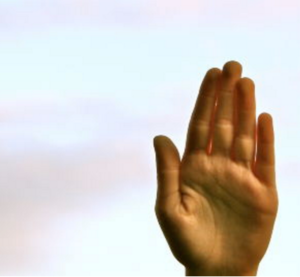My neighbors vote on preparedness. The result?

“Raise your hand . . .”
At our recent homeowner’s association meeting, I asked for a show of hands:
“How many of you have set aside food and water for an emergency?”
Response was good. About 80% of the 100 or so people there raised a hand.
Next question:
“How many of you are prepared to provide your neighbor with food and water?”
Hands that had been raised to answer the first question went down immediately.
We all looked around. Not a single hand was visible. The sound of weak laughter was heard, then it died away.
Even after years of effort in building a neighborhood emergency response group, we recognize that . . .
Being prepared seems mostly to be a commitment to oneself.
On the other hand (pun!), a number of our neighbors are willing to encourage and even help others prepare. Based on the “vote” above, you might not expect this commitment. What’s behind it?
What gets and keeps a neighborhood emergency response group going?
Every so often we quiz everyone in our own neighborhood group about why they are a part of it – when we really don’t have many emergencies to respond to!
Here’s what we know about our members.
- They have a “social conscience.” The most common answer to why they participate is always the same: “I want to give back.”
- They feel a sense of responsibility for the community, and typically are engaged with other neighbors one way or another.
- They acknowledge the risks that face the community. In our case, those risks include earthquake, wildfire, and, more frequently, loss of electricity and water. And, in an earthquake, broken gas mains.
- They like feeling empowered. Our group members are familiar with the infrastructure of our community. They know where First Responders come from and how long it takes them to get here. They understand how our mobile radio station works and who we’ll be calling in an emergency. And they know the limitations that our property managers operate under.
- They like their gear. Our members use their walkie-talkies every month, and bring battery-operated lanterns, first aid kits and fire extinguishers to meetings when we advertise a “show and tell.” (And they really like winning the door prize – even if it’s a simple $2 LED flashlight.)
How to encourage more people in the neighborhood to prepare for themselves?
We have found that people who aren’t willing to take steps on their own to prepare for emergencies will sometimes respond – slowly and maybe begrudgingly – to repeated messages of . . .
- Guilt (“What will your children say when they are hungry and you didn’t think ahead enough to provide for them?”)
- Fear (“Imagine being trapped under debris, in the dust and dark, unable to move . . .”)
- A friendly helping hand (“Here’s a simple list of the top 5 things to do, and a bottle of water to get started.”)
How to encourage more people to join in the neighborhood emergency response group?
To be successful, any group has to offer benefits to its members. We try to focus on some of these in our communications and monthly meetings . . .
- Make it fun! (I mentioned door prizes above. They do work at meetings! And we try to include a joke once in a while in our “educational” pieces.)
- Give everybody a job that helps make a meeting a success – set up the room, be a greeter, take notes, whatever.
- Recognize accomplishments – new CERT graduates, someone who used a skill learned in the group in a real life situation. Last month one of our members connected with a relative in another state and got some good preparedness info passed along to a whole new audience!
- Keep training. Our members like to keep learning new stuff. (They particularly like learning from new instructors – some of whom are now coming from videos on YouTube.)
- Make it easy to join. Have a welcome and orientation package for new group members. Ease them in; they don’t have to know everything you know on their very first day.
As I write this, I realize I’m writing in part for myself! Having been actively involved in our neighborhood group ever since I took the CERT training in 2002, I’ve observed and tried every one of the suggestions above! Over the years, the size of our group has varied from 15 or so to as many as 85, and then come back down again.
As we have said many times, preparedness is much more a STATE OF MIND than a stash of emergency supplies. And in a real emergency, it’s the people closest to you – that is, your neighbors – who will be the true First Responders. The more THEY know, the more prepared THEY are, the safer YOU will be!
So, I guess we just keep keeping on!
Please add your comments to this post, and your suggestions for inspiring people to take action for themselves and to take action for their neighbors, too.
It’s the best we can do!
Virginia
Your Emergency Plan Guide Team
P.S. If you are building a neighborhood group, please take a look at the manual I put together a few months ago. It details many of the successful meeting we’ve held over the past few years. If you’re in the midst of planning a neighborhood meeting right now, it will be a big help!
Don't miss a single Advisory.
Thank you for subscribing.
Something went wrong.
